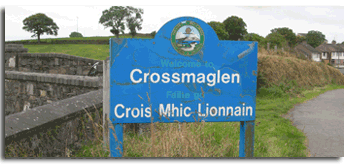Crossmaglen History

Crossmaglen (Crois Mhic Lionnáin ) is a village in County Armagh, Northern Ireland, near the border with the Republic of Ireland. It lies about 8 miles northwest of Dundalk and 14 southwest of Newry. It is the largest village in South Armagh. The village centre is the site of a large British army and Police Service of Northern Ireland (formerly the Royal Ulster Constabulary) base and observation tower (known locally as the “spy tower”). Crossmaglen has been described by Belfast journalist Malachi O’Doherty as “southern town that had the border laid down on the wrong side of it.”
The origin of the name “Crossmaglen” is uncertain. It has been interpreted as Cros-magh-gleana, “The cross of the shading plain”, and Cros Mhic Lionnáin¡in “McGlynn’s crossroads”. The common meaning is Lennon’s Cross, a reference to the two roads which intersect at the town square, linking Dundalk with Keady and Carrickmacross with Newry. Lennon is believed to be Owen Lennon, a local resident in the eighteenth century and who was famed as the owner of a shebeen, an illegal ale house.
The square’s name commemorates Cardinal Tomás Ó Fiaich, a local man who became Primate of All Ireland (head of the Roman Catholic Church in Ireland), and who died in 1990. Locals claim the square is the largest in Western Europe, after St. Peter’s in Rome.
Crossmaglen is classified as a village by the NI Statistics and Research Agency (NISRA). On Census day (29 April 2001) there were 1,459 people living in Crossmaglen. Of these:
27.0% were aged under 16 and 14.8% were aged 60 and over
48.6% of the population were male and 51.4% were female
99.0% were from a Catholic background and 0.8% were from a Protestant background
6.5% of people aged 16-74 were unemployed.
From Lewis’ Topographical Dictionary of Ireland – 1837:
Crossmaglen, a village, in that part of the parish of CREGGAN which is in the barony of UPPER FEWS, county of ARMAGH, and province of ULSTER, 8 miles (N. W.) from Dundalk, on the road to Newtown-Hamilton; containing 545 inhabitants. It comprises about 100 houses, of which several are large and well built, and has a penny post to Dundalk: the surrounding scenery is strikingly diversified. In the vicinity is a small lake, called Lough Maglen, or Magherlin; and there are numerous others in the surrounding district. The slate quarries here were formerly worked to some extent, but they are now in a declining state, A market for provisions is held on Friday; and there are fairs on the last Friday in every month for black cattle, horses, sheep, and pigs. A constabulary police station has been established in the village; and a spacious and handsome R. C. chapel has been recently erected, which is the parochial chapel of a very extensive district, called Lower Creggan. A dispensary was built by subscription in 1830.
The Gregory family has resided in the Crossmaglen area for almost 200 years, with the first documented Gregory event being the marriage of Christopher Gregory and Margaret Downey on 6 Jan 1814. They are the great great great grandparents of the Webmaster. Margaret Downey was born in Creggan parish on 14 Jan 1798. The Gregory’s have actually settled in the townlands surrounding Crossmaglen, mainly Mobane, Clonalig and Drumboy.
It is very strange that the name Crossmaglen never appeared in any of the Inquisition or Census Lists as Crossmaglen. It has shown up as Cross or Crosse which there is still some local useage. In the Escheated County Maps published in 1609, the name Cross-moy-glane is present. Even though the name “Cros-á¹ig-Floinn” appears on all the sign posts, there is some distrust in this derivation. The old Gaelic speaker of Clonalig and Hackballscross districts used “Cros-á¹ig-Lionnain”. This name could be in reference to the keeper of a local ale-house named Lennon, possibly Owen Lennon, who was one of the only five householders listed in the Census of 1766. The house could have been located at the cross roads and thus the name Cros-á¹ig-Lionnain.
If the village was named after a family, the first inclination would be the MacCleans or MacClanes, based on the map of 1609. There were no Flynns (as suggested by “Cros-á¹ig-Floinn”), one Lennon and several MacClanes. Crossmaglen may be identified with the ancient Magh Leamhna. This is still being researched.
According to the Cromwellian Confiscations of the Upper Fews in the Parish of Creggan, most of the land was owned by Henry O’Neill, an Irish Papist in 1641. In addition to Armagh, Thomas Ball received extensive grants in the barony of Orier and in the counties of Meath, Westmeath, Kerry and Down. The total acreage he received in Armagh was about 3,911. This comprised of many townlands including Crosse (Crossmaglen), Cullyhana, Urcher and Creenkill. Other townlands such as Clonalig, Drumboy and Mobane were granted to Edward Rowley in the time of Cromwell, but they were not included in the Acts of Settlement as they had been purchased by and conveyed to Thomas Ball.
The 1659-60 Census of the Fews states that there were 11 people living in Drumbee (Drumboy) and 10 in Clonligg (Clonalig).
List of the Families in the Parish of Creggan of Selected Townlands in the County of Armagh – 8 April 1766
CLONALIGG
Owen McKenna
John McArdle
Hugh Harvassey
John McMahonDRUMBEE
Robert Waters
F. Campbell
Ross McKenna
Edward Carragher
Bryan Burn
Patrick HughsCROSS
Dennis Keenan
Terence Canaway
Bryan McGill
James Makkin
Hugh McShane
Owen McGrane
Owen Lennan
Patrick Keenan






